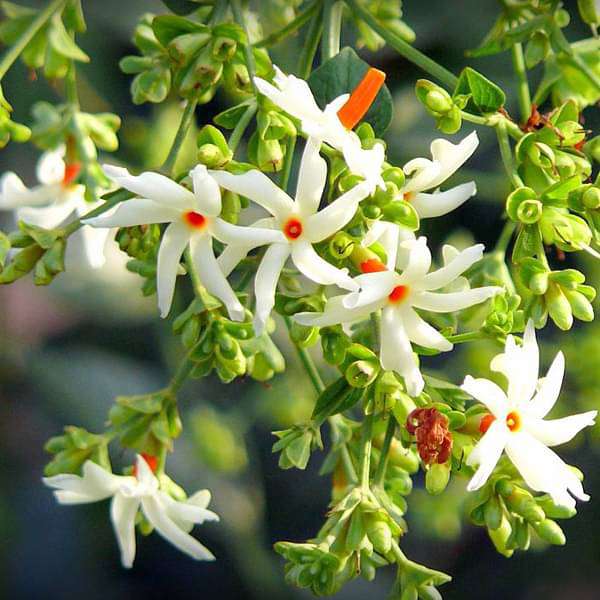
The Parijat (Nyctanthes arbor-tristis) is a revered flowering plant in Indian and Southeast Asian cultures, prized for its breathtaking beauty and medicinal properties. Also known as the Night-Flowering Jasmine or Sadabahar, this shrub-like plant requires careful attention to thrive. In this article, we’ll delve into the intricacies of Parijat plant care.
Lighting
Parijat plants prefer:
- Bright, indirect sunlight (4-6 hours/day)
- Partial shade, especially in warmer climates
- Avoid direct sunlight, which can cause leaf scorch
Watering
- Water regularly, but avoid overwatering
- Soil should be moist, not waterlogged
- Reduce watering in winter months (Oct-Feb)
Soil
- Well-draining soil with a pH range of 6.0-7.0
- Mix organic matter like compost or manure for improved fertility
Temperature
- Ideal temperature range: 65°F-90°F (18°C-32°C)
- Avoid temperatures below 55°F (13°C) or above 100°F (38°C)
Fertilization
- Feed with balanced fertilizer (10-10-10 NPK) during growing season (Mar-Sep) or use blooming fertilizer like a 7-9-5
- Dilute fertilizer to half the recommended strength for young plants
Pruning
- Prune after flowering to maintain shape and promote new growth
- Remove dead or damaged branches
Propagation
- Stem cuttings: Take 3-4 inch cuttings, remove lower leaves, and plant in moist soil
- Seed propagation: Sow seeds in spring or summer, maintaining consistent moisture
Pest and Disease Management
- Watch for pests: Aphids, whiteflies, and spider mites
- Regularly inspect for diseases: Leaf spot, root rot, and powdery mildew
- Use organic pest control methods whenever possible
Tips and Variations
- Parijat is a relatively low-maintenance plant
- Can be grown in containers or as a hedge
- Varieties include single-flowered and double-flowered cultivars
Tips for Maximizing Flower Production
- Provide optimal temperature: Parijat flowers best in temperatures between 75°F-85°F (24°C-29°C).
- Maintain soil fertility: Feed with organic matter like compost or manure to enhance soil fertility.
- Water wisely: Consistent moisture promotes flowering, but avoid waterlogging.
- Prune judiciously: Remove spent flowers and trim back stems to encourage new blooms.
- Provide support: Train stems to grow upright or provide trellis support for better flowering.
- Mulch around base: Retain moisture, suppress weeds, and regulate soil temperature.
- Avoid over-fertilization: Excessive nitrogen can reduce flowering.
- Monitor pH levels: Maintain slightly acidic to neutral soil pH.
- Deadheading: Remove spent flowers to encourage new blooms.
- Repotting: Transplant every 2-3 years to refresh soil and promote healthy growth.
Additional Flower-Boosting Secrets
- Evening watering: Water plants in the evening to mimic natural dew.
- Soil conditioning: Add flower-promoting substances like bone meal or fish emulsion.
- Pinch pruning: Pinch off terminal buds to encourage branching.
- Air circulation: Ensure good air circulation to prevent fungal diseases.
- Seasonal care: Reduce watering and fertilization during winter months.
Conclusion
With proper care and attention, the Parijat plant will reward you with stunning flowers and a tranquil presence. By following these guidelines, you’ll be well on your way to becoming a skilled Parijat plant caretaker.
Happy gardening!
